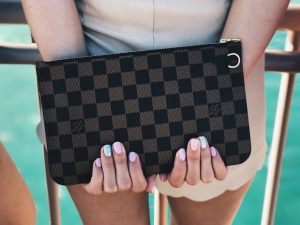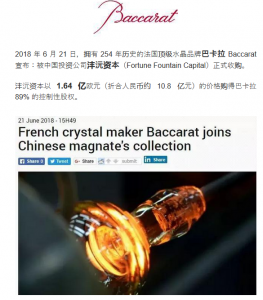
« Made in France », popular topic with Chinese consumers
China has entered a phase of economic expansion for some decades. Previously, the country followed the doctrine of “tao guang yang hui 韬光养晦” (“keep a low profile and bide your time, while also getting something accomplished”), a low profile strategy developed by Deng Xiaoping in 1991. It included staying neutral in all circumstances, focusing on China’s economic development, and fostering friendly relations with all countries.
From now on, the new pattern of conquest of the international markets consists of “Going Out Policy” (“zouchuqu 走出去”). The principle was theorized in 1999 by the Chinese Communist Party, in order to allow Chinese companies to increase their influence on the world market. The Confucius Institutes, the financing of road, rail or airport infrastructures in several countries, or the internationalization of investment banks (AIIB – Asian Infrastructure Investment Bank, Exim Bank – Export Import Bank of China and China Development Bank) contribute to this growth of the Chinese business community.
The most typical example is the One Belt, One Road (OBOR) / Yidai yilu 一带 一路 strategy, renamed Belt & Road Initiative. It was stated in September 2013 by President Xi Jinping. It aims to build new maritime links and rail routes from China, in the spirit of reviving the ancient Silk Roads, to Europe or Africa for example.
French luxury, synonymous with quality and refinement
If France is illustrated in many areas, fashion and the French way of life are still very popular with the Chinese. France is associated with the symbols of know-how, quality and good taste. Indeed, the skills and techniques handed down over generations by luxury artisans represent a guarantee of excellence. Many brands have existed for several decades or centuries, such as Lanvin House, the oldest French fashion house still in business (since 1889). This heritage, beyond reassuring consumers (especially against counterfeiting), makes them apprehend a world of historical representations and symbols, like traditional Chinese culture.

Luxury meets the criteria of the wealthy Chinese social class. Indeed, the Chinese model is “based on power, knowledge, and wealth,” which is not at odds with “the Western aspirational model of performance and asset accumulation,” according to a study of the French research company Ipsos. As a general rule, owning a branded clothing or luxury accessory makes it possible to assert one’s social status and insurance with one’s family. This also proves his financial capabilities.
In addition, luxury makes it possible to distinguish itself, because the appearance in China is paramount. This is close to the Chinese concept of “Mianzi 面子”, that is to say the face, the appearance, “the way a person will be perceived in society” according to Pierre Picquart, a specialist in China. Thus, adopting a luxury brand is a way of highlighting one’s lifestyle, which gives prestige and respect within one’s social circle.
In search of renaissance, French brands are acclaimed by Chinese buyers
Despite their renown, some French brands are in financial difficulties, even in receivership for others. The last transaction dates from October 12, 2018, and this is the brand of luxurious Carven ready-to-wear, founded in 1945. Icicle Fashion Group, the new owner promoting a high-end eco-friendly fashion, has announced its intention to “revive the Carven brand in France, China and the international market”. In April 2018, the Chinese group La Chapelle made its first acquisition outside China, buying the women’s ready-to-wear brand Naf Naf. In February 2018, Lanvin is acquired by Fosun (also owner of Club Med). The goal is to allow him to “enter a new phase of expansion”. Finally, in October 2017, the Baccarat crystal factory falls into the hands of a Chinese investment fund, Fortune Fountain Capital.

For Chinese investors, these buybacks are an opportunity to gain a foothold in strategic sectors. In fact, the markets for clothing, tourism and tableware are becoming increasingly important in China, particularly thanks to the development of e-commerce and social networks. Chinese investment funds aim at the renewal and redeployment of these brands. Some rely primarily on expansion in China, as shown by the opening of 500 outlets in China by 2025 for Naf Naf. While others aim for an international extension or even a diversification (for example in bars, lounges or restaurants for Baccarat).
This buyback policy is encouraged by the Chinese government through its five-year plans, which want domestic consumption to also enrich national companies. Until now, almost all luxury goods were held by major global groups (Richemont, etc.), including French (LVMH or Kering for example). By owning some famous foreign brands in China, Chinese groups also hope to take advantage of the appeal of these legendary brands on wealthy Chinese classes.
French products always more in demand
The number of acquisitions of French companies by Chinese groups shows the growing interest of Chinese investors in the “Made In France” brand. In addition, where signs of slowing ultra-luxury begin to emerge, affordable luxury is growing, and French brands are still attracting more customers. The Confucian cultural heritage and the denunciation of corruption in China has made the external signs of wealth less acceptable. As an example, the latest fashionable challenge “Falling Stars“, initiated by children of Russian billionaires and taken over by the Chinese, provoked outrage.

Ec24m account screenshot (26/11/18)
In addition, Chinese consumers, always looking for novelties, are weary of wearing the same brands as their fellow citizens. The usual products, available in multiple places, lose their exclusivity (the luxury shops have thus invested the cities of 2nd-3rd tier in China). It is therefore an undeniable opportunity for French companies. The most important thing is to make yourself known through social networks, indisputable vectors of information in China, then to partner with distributors.
The installation of a brand in a foreign culture is a real challenge. Adequate and targeted communication is therefore essential. As an example, the Chinese are paying a lot of attention to the work of “influencers“. In the same way, Chinese consumers are more likely to believe and be influenced by the experiences of their loved ones or the personalities they value.
If you want support on your communication in China, do not hesitate to contact us at info@shuo-digital.com.